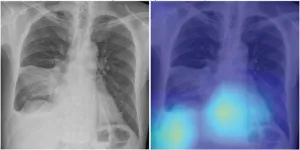Deep-learning chest radiograph model predicts mortality for community-acquired pneumonia
A deep learning-based model using initial chest radiographs predicted 30-day mortality in patients with community-acquired pneumonia, improving upon the performance of an established risk prediction tool
2023-06-30
(Press-News.org) Leesburg, VA, June 30, 2023—According to an accepted manuscript published in ARRS’ own American Journal of Roentgenology (AJR), a deep learning-based model using initial chest radiographs predicted 30-day mortality in patients with community-acquired pneumonia (CAP), improving upon the performance of an established risk prediction tool (i.e., CURB-65 score).
“The deep learning (DL) model may guide clinical decision-making in the management of patients with CAP by identifying high-risk patients who warrant hospitalization and intensive treatment,” concluded first author Eui Jin Hwang, MD, PhD, from the department of radiology at Seoul National University College of Medicine in Korea.
In this AJR accepted manuscript, a DL model was developed in 7,105 patients via one institution from March 2013 to December 2019 (3:1:1 allocation to training, validation, and internal test sets) to predict risk of all-cause mortality within 30 days after CAP diagnosis using patients’ initial chest radiograph. Hwang et al. then evaluated their DL model in patients diagnosed with CAP during emergency department visits at the same institution as the development cohort from January 2020 to December 2020 [temporal test cohort (n = 947)], and from two additional different institutions [external test cohort A (n = 467), January 2020 to December 2020; external test cohort B (n = 381), March 2019 to October 2021]. AUCs were compared between the DL model and a risk score based on confusion, blood urea nitrogen level, respiratory rate, blood pressure, and age ≥ 65 years.
Ultimately, a DL model using initial chest radiographs predicted 30-day all-cause mortality in patients with CAP with AUC ranging from 0.77 to 0.80 in test cohorts from different institutions. Additionally, the model showed higher specificity (range, 61–69%) than the CURB-65 score (44–58%) at the same sensitivity (all p < .001).
An electronic supplement to this AJR accepted manuscript is available here.
North America’s first radiological society, the American Roentgen Ray Society (ARRS) remains dedicated to the advancement of medicine through the profession of medical imaging and its allied sciences. An international forum for progress in radiology since the discovery of the x-ray, ARRS maintains its mission of improving health through a community committed to advancing knowledge and skills with the world’s longest continuously published radiology journal—American Journal of Roentgenology—the ARRS Annual Meeting, InPractice magazine, topical symposia, myriad multimedia educational materials, as well as awarding scholarships via The Roentgen Fund®.
MEDIA CONTACT:
Logan K. Young, PIO
44211 Slatestone Court
Leesburg, VA 20176
lyoung@arrs.org
END
[Attachments] See images for this press release:

ELSE PRESS RELEASES FROM THIS DATE:
2023-06-30
(Santa Barbara, Calif.) — The universe is expanding; we’ve had evidence of that for about a century. But just how quickly celestial objects are receding from each other is still up for debate.
It’s no small feat to measure the rate at which objects move away from each other across vast distances. Since the discovery of cosmic expansion, its rate has been measured and re-measured with increasing precision, with some of the latest values ranging from 67.4 up to 76.5 kilometers per second per megaparsec, which relates the recession velocity (in ...
2023-06-30
“[...] we see our work as an indication that combining different molecular data types could be a general strategy to improve future aging clocks.”
BUFFALO, NY- June 30, 2023 – A new research paper was published on the cover of Aging (listed by MEDLINE/PubMed as "Aging (Albany NY)" and "Aging-US" by Web of Science) Volume 15, Issue 12, entitled, “Age prediction from human blood plasma using proteomic and small RNA data: a comparative analysis.”
Aging clocks, built from comprehensive molecular data, have emerged as promising tools ...
2023-06-30
How can you tell if a fruit fly is hungry? Ask a computer.
While that may sound like a bad dad joke, it’s reality at Tulane University, where researchers have developed a new A.I. tool that can tell you if a fruit fly is hungry, sleepy or singing (yes, fruit flies sing).
Dubbed MAFDA (for Novel Machine-learning-based Automatic Fly-behavioral Detection and Annotation) the system uses cameras and a newly developed software to track and identify complex interactive behaviors of individual flies within a larger group. This allows researchers to compare and contrast the behaviors of fruit flies with different genetic backgrounds.
For more than a century, ...
2023-06-30
LA JOLLA, CALIF. – June 30, 2023 – A study led by researchers at Sanford Burnham Prebys has found that in young women, certain genetic mutations are associated with treatment-resistant breast cancer. These mutations are not linked to treatment-resistant breast cancer in older women. The findings, published in the journal Science Advances, could help improve precision medicine and suggest a brand-new way of classifying breast cancer.
“It’s well established that as you get older, you’re more likely to develop cancer. But we’re finding that this may not be true for all cancers depending on a person’s genetic makeup,” ...
2023-06-30
CHAMPAIGN, Ill. — Flexible displays that can change color, convey information and even send veiled messages via infrared radiation are now possible, thanks to new research from the University of Illinois Urbana-Champaign. Engineers inspired by the morphing skins of animals like chameleons and octopuses have developed capillary-controlled robotic flapping fins to create switchable optical and infrared light multipixel displays that are 1,000 times more energy efficient than light-emitting devices.
The new study led by mechanical science and engineering professor Sameh Tawfick demonstrates ...
2023-06-30
AURORA, Colo. (June 30, 2023) – Researchers from the University of Colorado Anschutz Medical Campus have identified a potential new immune checkpoint receptor that could lead to treatments for diseases such as lung and bowel cancer and autoimmune conditions including IBD.
The study, published today in Science Immunology, examines a family of 13 receptors, or proteins that transmit signals for cells to follow, called killer cell immunoglobulin-like receptors (KIR). Of the 13 receptors, one is unique in that it has not readily been observed on immune cells of ...
2023-06-30
A team of scientists from around the globe, including those from Trinity College Dublin, has gained high-res structural insights into a key bacterial enzyme, which may help chemists design new drugs to inhibit it and thus suppress disease-causing bacteria. Their work is important as fears continue to grow around rising rates of antibiotic resistance.
The scientists, led by Martin Caffrey, Fellow Emeritus in Trinity’s School of Medicine and School of Biochemistry and Immunology, used next-gen X-ray crystallography and single particle cryo-electron microscopy ...
2023-06-30
UNIVERSITY PARK, Pa. — Experiencing traumatic events such as natural disasters may have long-term consequences for the academic progress and future food security of youth — a problem researchers said could worsen with the increased frequency of extreme weather events due to climate change.
In a study using data from Peru, researchers from Penn State’s College of Agricultural Sciences found that being exposed to a greater number of traumatic events or “shocks,” such as a natural disaster or loss of family income, in early ...
2023-06-30
Researchers have demonstrated a new material for single-molecule electronic switches, which can effectively vary current at the nanoscale in response to external stimuli. The material for this molecular switch has a unique structure created by locking a linear molecular backbone into a ladder-type structure. A new study finds that the ladder-type molecular structure greatly enhances the stability of the material, making it highly promising for use in single-molecule electronics applications.
Reported in the journal Chem, the study shows that the ladder-type molecule serves as a robust and reversible molecular switch over a wide range of conductivity levels and different molecular ...
2023-06-30
A $7 million study beginning this summer at Wake Forest University and Wake Forest University School of Medicine will help determine whether a combination of resistance training plus bone-strengthening exercises and/or osteoporosis medication use can help older adults safely lose weight without sacrificing bone mass.
That paradox – that shedding pounds can help stave off heart disease and diabetes while increasing bone loss and subsequent fracture risk – has been a focus of Wake Forest researcher Kristen Beavers for about a decade.
Her previous research ...
LAST 30 PRESS RELEASES:
[Press-News.org] Deep-learning chest radiograph model predicts mortality for community-acquired pneumonia
A deep learning-based model using initial chest radiographs predicted 30-day mortality in patients with community-acquired pneumonia, improving upon the performance of an established risk prediction tool




